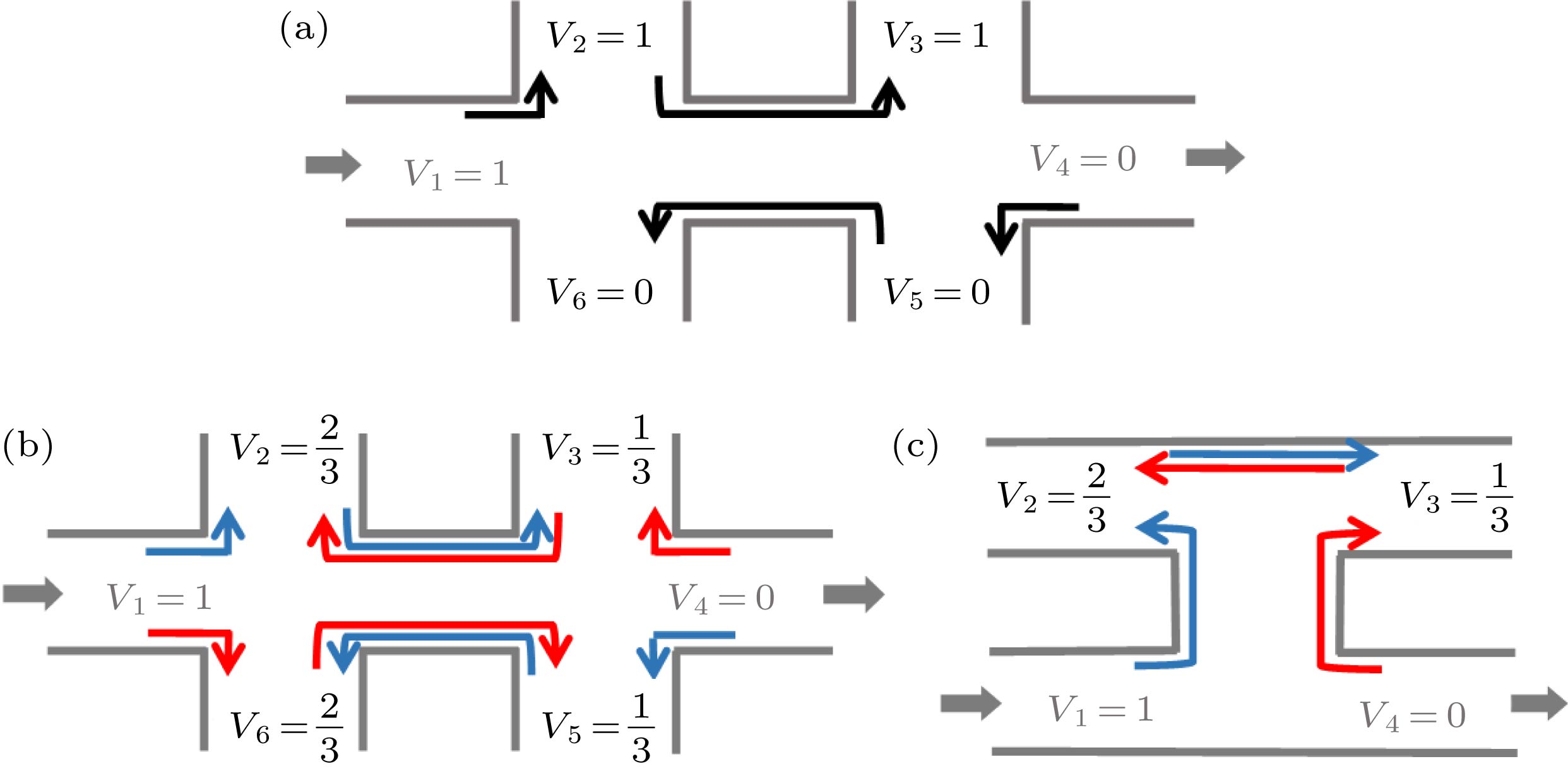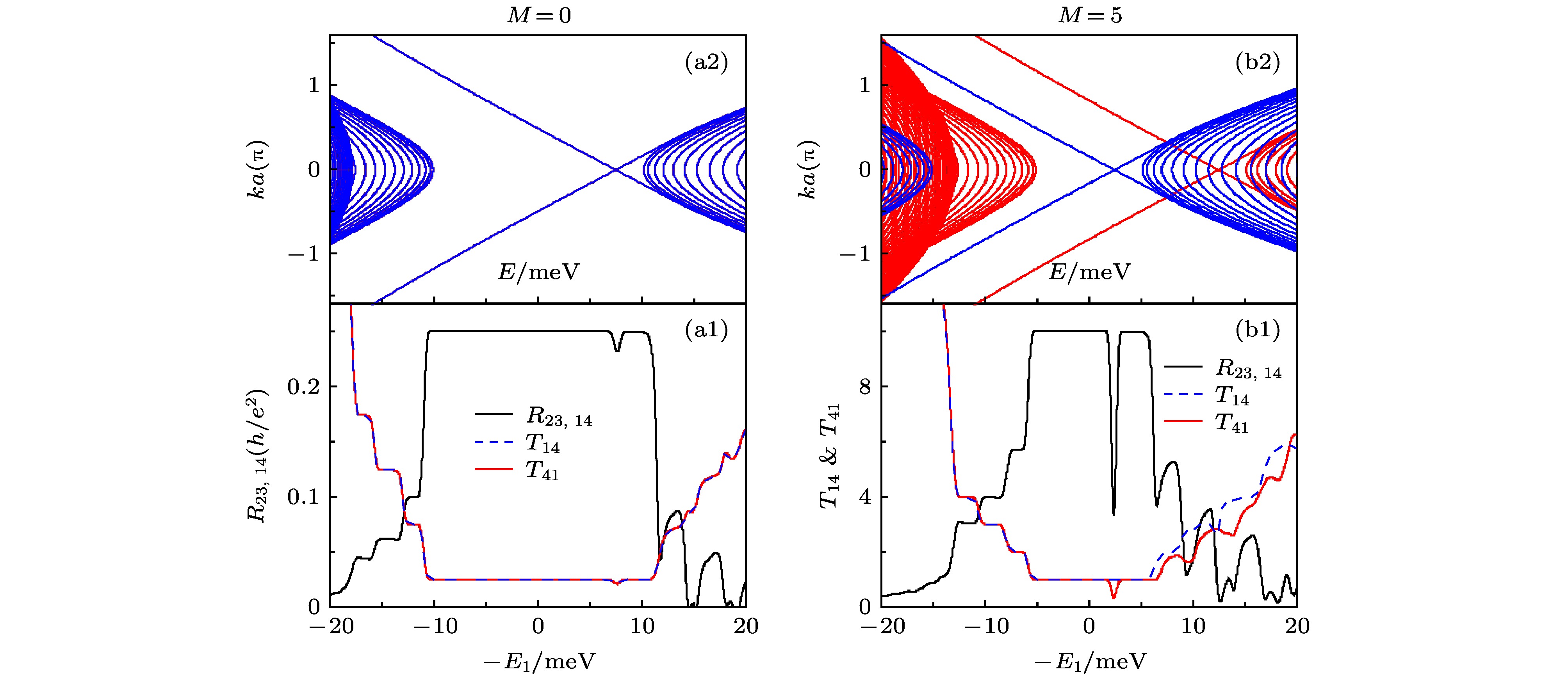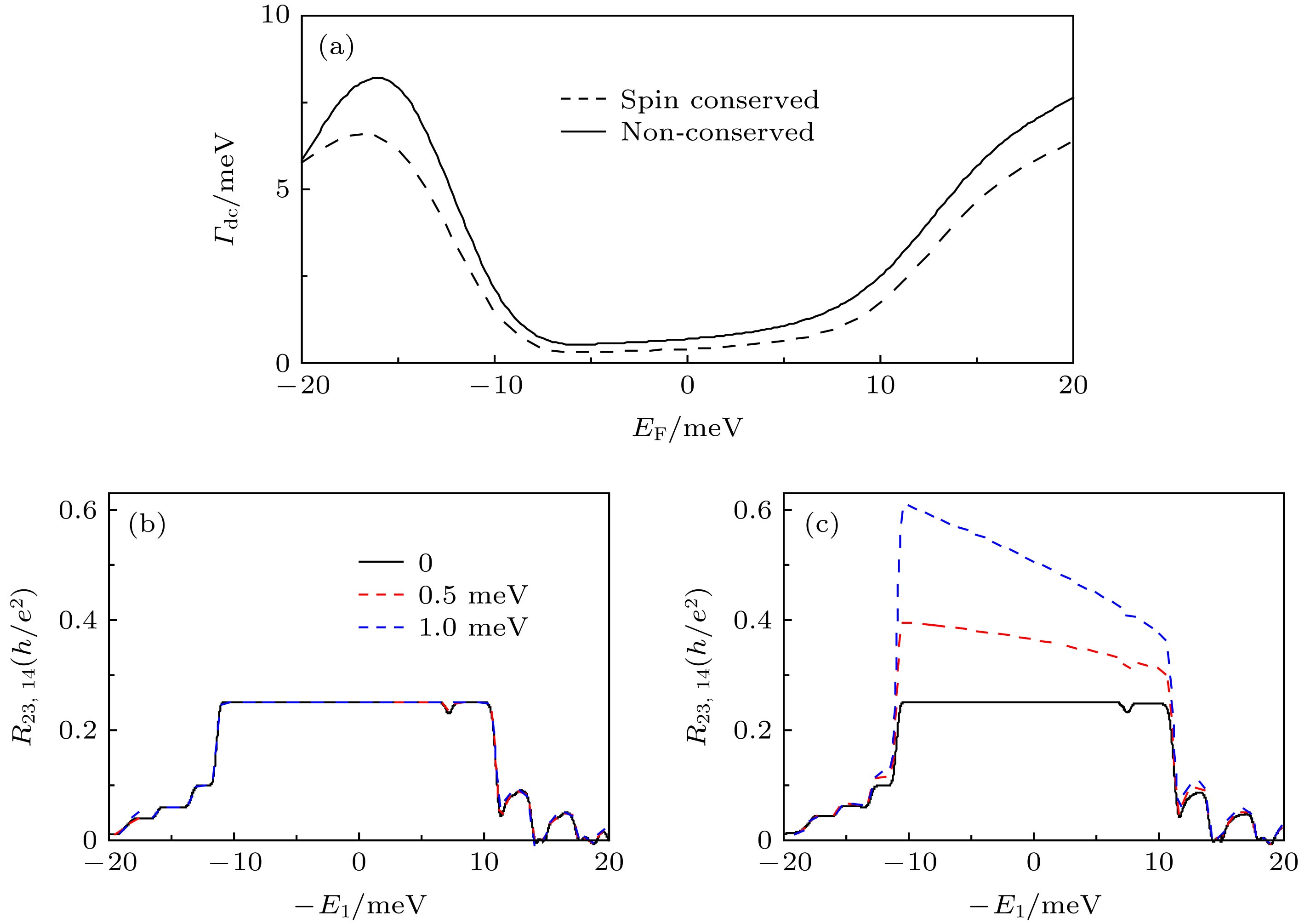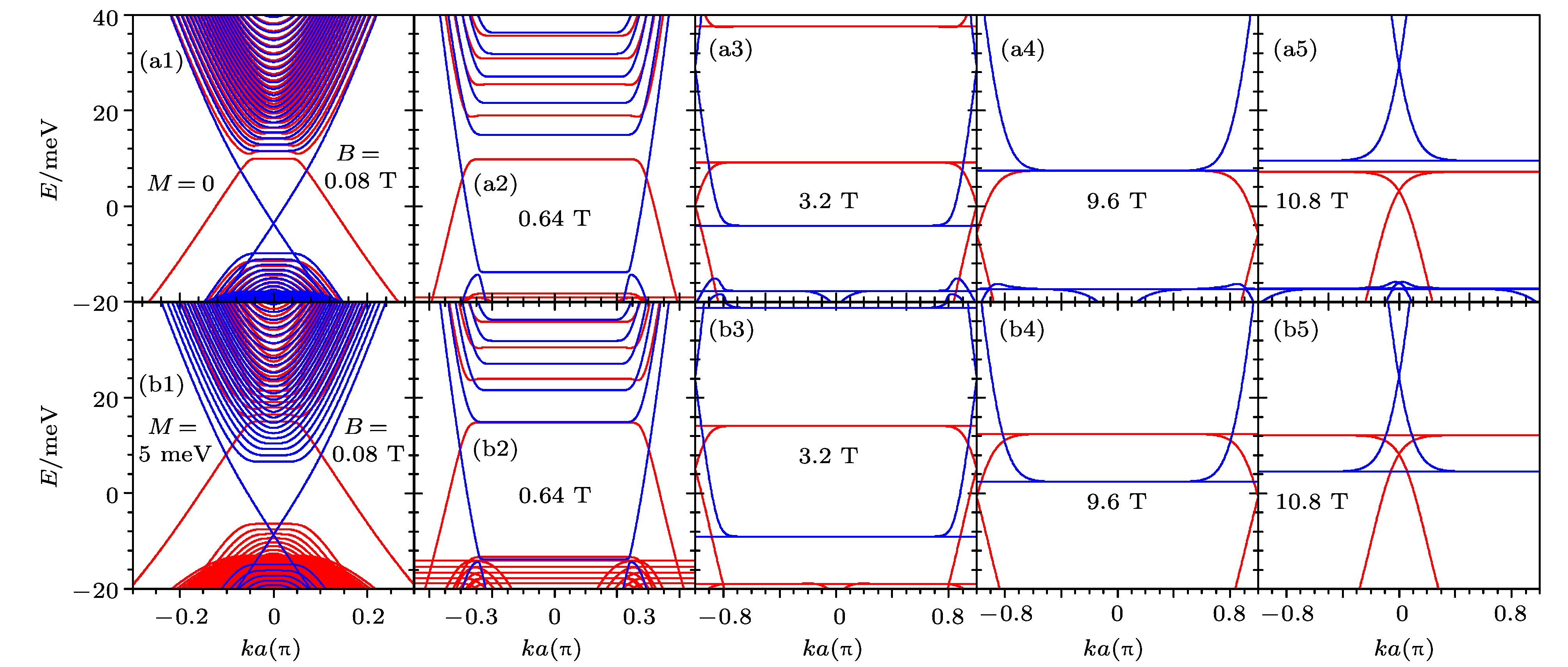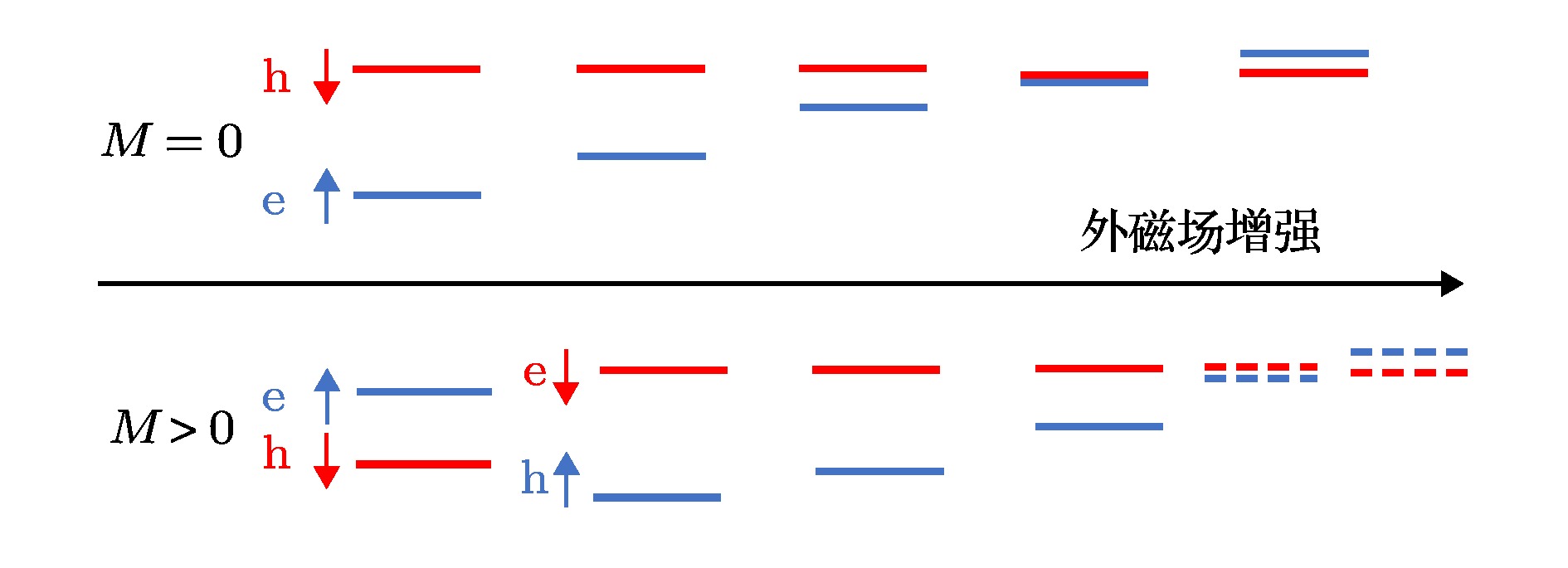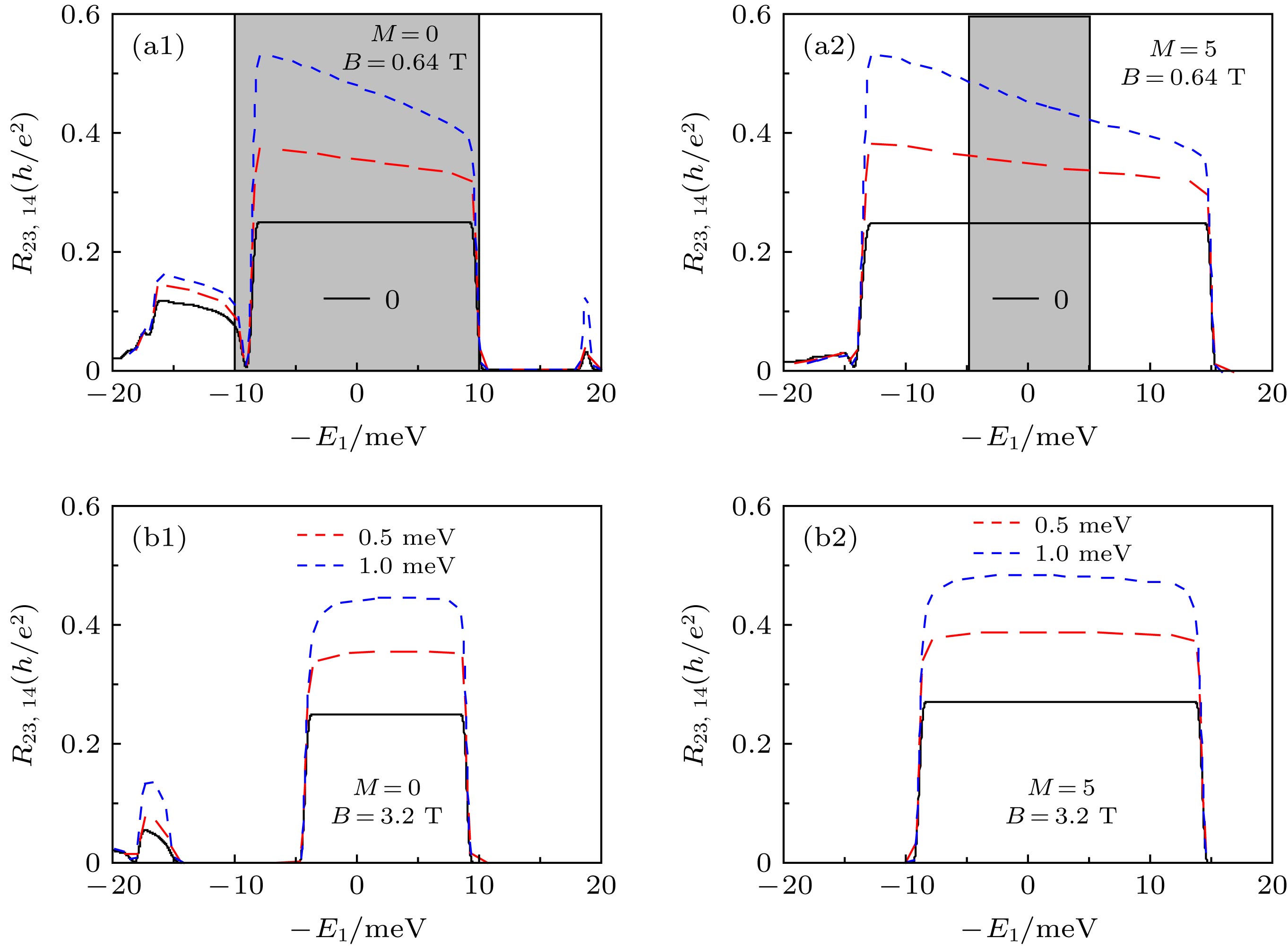-
HgTe/CdTe量子阱是一种特殊的二维拓扑材料, 其中的量子自旋霍尔效应在自旋电子器件应用方面极有潜力. “工”字形四端口体系纵向非局域电阻阻值为
$0.25\;h/e^{2}$ 的特殊的量子化平台是判别量子自旋霍尔效应的有力证据. 本文基于二维HgTe/CdTe量子阱模型, 利用非平衡格林函数理论及Landauer-Büttiker公式计算非局域电阻, 进而研究自旋拓扑态在非静态杂质作用下的退相干效应. 计算同时考虑磁交换场和磁场的影响. 研究发现, 尽管磁交换场和外磁场会破坏时间反演对称性, 但它们都仅改变拓扑带隙的宽度和相对位置, 并不影响螺旋边缘态的拓扑性. 而退相干杂质对自旋拓扑边缘态的影响则完全不同于铁磁和弱磁场. 退相干效应不会影响拓扑带隙的位置和宽度, 但是会影响拓扑边缘态的稳定性. 其中, 自旋不守恒的退相干杂质对螺旋边缘态的影响更为明显, 轻微的退相干效应便会引起自旋翻转, 从而引起自旋相反的背散射, 最终破坏自旋霍尔边缘态.HgTe/CdTe quantum well is a typical two dimensional topological material which supports the helical edge states and quantum spin Hall effect that is imposing in applying of spin electronic devices. The special plateau valued with$0.25\;h/e^{2}$ of nonlocal resistance in H-shaped four terminal devices can be used as the fingerprint of quantum spin Hall effect. Based on the HgTe/CdTe quantum well, with the aid of nonequilibrium Green's function theory and multi-terminal Landauer-Büttiker formula, we calculate the nonlocal resistance and study the dephasing effect of spin topological states in the presence of exchange field and external magnetic field. It is found the dephasing processes play a role completely different from exchange field and external magnetic field. The latter destroy time reversal symmetry and change the width and relative position of topological gap, but do not influent the topological stability of helical edge states. In the contrary, dephasing processes don't change the width and relative position, however, they broke the topological stability. We consider two kinds of dephasing: normal dephasing and spin dephasing. In the first kind, the carriers lose only the phase memory while maintaining the spin memory. In the second kind, the carriers lose both phase and spin memories. Because of the spin locking properties, normal dephasing almost have no influence on the helical edge states. While the spin dephasing will induce spin flip backscattering and finally destroy helical edge states seriously.-
Keywords:
- quantum transport /
- quantum spin Hall /
- nonlocal resistance /
- dephasing
[1] Kane C L, Mele E J 2005 Phys. Rev. Lett. 95 226801
 Google Scholar
Google Scholar
[2] Zhang F, Zhou J, Xiao D, Yao Y 2017 Phys. Rev. Lett. 119 266804
 Google Scholar
Google Scholar
[3] Schindler F, Cook A M, Vergniory M G, Wang Z, Parkin S S, Bernevig B A, Neupert T 2018 Sci. Adv. 4 eaat0346
 Google Scholar
Google Scholar
[4] Hasan M Z, Kane C L 2010 Rev. Mod. Phys. 82 3045
 Google Scholar
Google Scholar
[5] Alexandradinata A, Wang Z, Bernevig B A 2016 Phys. Rev. X 6 021008
[6] König M, Wiedmann S, Brüne C, Roth A, Buhmann H, Molenkamp L W, Qi X L, Zhang S C 2007 Science 318 766
 Google Scholar
Google Scholar
[7] Bernevig B A, Hughes T L, Zhang S C 2006 Science 314 1757
 Google Scholar
Google Scholar
[8] Yang W, Chang K, Zhang S C 2008 Phys. Rev. Lett. 100 056602
 Google Scholar
Google Scholar
[9] Liu C C, Feng W, Yao Y 2011 Phys. Rev. Lett. 107 076802
 Google Scholar
Google Scholar
[10] Xu Y, Yan B, Zhang H J, Wang J, Xu G, Tang P, Duan W, Zhang S C 2013 Phys. Rev. Lett. 111 136804
 Google Scholar
Google Scholar
[11] Hsieh D, Qian D, Wray L, Xia Y, Hor Y S, Cava R J, Hasan M Z 2008 Nature 452 970
 Google Scholar
Google Scholar
[12] Chen Y L, Analytis J G, Chu J H, Liu Z K, Mo S K, Qi X L, Zhang H J, Lu D H, Dai X, Fang Z, Zhang S C, Fisher I R, Hussain Z, Shen Z X 2009 Science 325 178
 Google Scholar
Google Scholar
[13] Zhang L, Zhuang J, Xing Y, Li J, Wang J, Guo H 2014 Phys. Rev. B 89 245107
 Google Scholar
Google Scholar
[14] Xing Y, Xu F, Cheung K T, Sun Q F, Wang J, Yao Y 2018 New J. Phys 20 043011
 Google Scholar
Google Scholar
[15] Xing Y, Xu F, Sun Q F, Wang J, Yao Y G 2018 J. Phys. Condens. Mat. 30 435303
 Google Scholar
Google Scholar
[16] Wada M, Murakami S, Freimuth F, Bihlmayer G 2011 Phys. Rev. B 83 121310
 Google Scholar
Google Scholar
[17] Chang K, Lou W K 2011 Phys. Rev. Lett. 106 206802
 Google Scholar
Google Scholar
[18] Liu C X, Qi X L, Dai X, Fang Z, Zhang S C 2008 Phys. Rev. Lett. 101 146802
[19] Xing Y, Sun Q F 2014 Phys. Rev. B 89 085309
 Google Scholar
Google Scholar
[20] Hinz J, Buhmann H, Schäfer M, Hock V, Becker C, Molenkamp L 2006 Semicond. Sci. Tech. 21 501
 Google Scholar
Google Scholar
[21] Piatrusha S, Khrapai V, Kvon Z, Mikhailov N, Dvoretsky S, Tikhonov E 2017 Phys. Rev. B 96 245417
 Google Scholar
Google Scholar
[22] Xue F, MacDonald A H 2018 Phys. Rev. Lett. 120 186802
 Google Scholar
Google Scholar
[23] Dolcetto G, Sassetti M, Schmidt T L 2015 arXiv preprint: 1511.06141
[24] Sticlet D, Cayssol J 2014 Phys. Rev. B 90 201303
 Google Scholar
Google Scholar
[25] Väyrynen J I, Pikulin D I, Alicea J 2018 Phys. Rev. Lett. 121 106601
 Google Scholar
Google Scholar
[26] Zhou B, Lu H Z, Chu R L, Shen S Q, Niu Q 2008 Phys. Rev. Lett. 101 246807
 Google Scholar
Google Scholar
[27] Dai X, Hughes T L, Qi X L, Fang Z, Zhang S C 2008 Phys. Rev. B 77 125319
 Google Scholar
Google Scholar
[28] Ohyama Y, Tsuchiura H, Sakuma A 2011 Journal of Physics: Conference Series 266 012103
 Google Scholar
Google Scholar
[29] Xing Y, Yang Z L, Sun Q F, Wang J 2014 Phys. Rev. B 90 075435
 Google Scholar
Google Scholar
[30] Zhang L B, Cheng F, Zhai F, Chang K 2011 Phys. Rev. B 83 081402
 Google Scholar
Google Scholar
[31] Xing Y, Zhang L, Wang J 2011 Phys. Rev. B 84 035110
 Google Scholar
Google Scholar
[32] Ren Y, Zeng J, Wang K, Xu F, Qiao Z 2017 Phys. Rev. B 96 155445
 Google Scholar
Google Scholar
[33] Wang K T, Xu F, Xing Y, Zhao H K 2018 Front. Phys. 13 1
 Google Scholar
Google Scholar
[34] Abanin D A, Morozov S V, Ponomarenko L A, Gorbachev R V, Mayorov A S, Katsnelson M L, Watanabe K, Taniguchi T, Novoselov K S, Levitov L S, Geim A K 2011 Science 332 328
 Google Scholar
Google Scholar
[35] Wang Z, Liu H, Jiang H, Xie X C 2016 Phys. Rev. B 94 035409
 Google Scholar
Google Scholar
[36] Renard J, Studer M, Folk J A 2014 Phys. Rev. Lett. 112 116601
 Google Scholar
Google Scholar
[37] Shimazaki Y, Yamamoto M, Borzenets I V, Watanabe K, Taniguchi T, Tarucha S 2015 Nat. Phys. 11 1032
 Google Scholar
Google Scholar
[38] Sui M, Chen G, Ma L, Shan W Y, Tian D, Watanabe K, Taniguchi T, Jin X, Yao W, Xiao D, Zhang Y 2015 Nat. Phys. 11 1027
 Google Scholar
Google Scholar
[39] Wang J, Lian B, Zhang H, Zhang S C 2013 Phys. Rev. Lett. 111 086803
 Google Scholar
Google Scholar
[40] Brüne C, Roth A, Buhmann H, Hankiewicz E M, Molenkamp L W, Maciejko J, Qi X L, Zhang S C 2012 Nat. Phys. 8 485
 Google Scholar
Google Scholar
[41] Krishtopenko S, Teppe F 2018 Phys. Rev. B 97 165408
 Google Scholar
Google Scholar
[42] Liu C X, Qi X L, Dai X, Fang Z, Zhang S C 2008 Phys. Rev. Lett. 101 146802
 Google Scholar
Google Scholar
[43] Ahn J, Yang B J 2017 Phys. Rev. Lett. 118 156401
 Google Scholar
Google Scholar
[44] Sun Q F, Xie X C 2010 Phys. Rev. Lett. 104 066805
 Google Scholar
Google Scholar
[45] Xing Y, Sun Q F, Wang J 2008 Phys. Rev. B 77 115346
 Google Scholar
Google Scholar
[46] Jiang H, Cheng S, Sun Q F, Xie X C 2009 Phys. Rev. Lett. 103 036803
 Google Scholar
Google Scholar
[47] Qi J, Liu H, Jiang H, Xie X C 2019 Front. Phys. 14 43403
 Google Scholar
Google Scholar
[48] Golizadeh-Mojarad R, Datta S 2007 Phys. Rev. B 75 081301
 Google Scholar
Google Scholar
[49] Zhang L, Yu Z, Xu F, Wang J 2018 Carbon 126 183
 Google Scholar
Google Scholar
[50] Datta S 1995 Electronic Transport in Mesoscopic Systems (1st ed.) (New York: Cambridge university press) pp79–93
[51] Jiang H, Wang L, Sun Q F, Xie X C 2009 Phys. Rev. B 80 165316
 Google Scholar
Google Scholar
[52] Sun Q F, Li Y X, Long W, Wang J 2011 Phys. Rev. B 83 115315
 Google Scholar
Google Scholar
-
图 1 (a) 四端口HgTe/CdTe量子阱模型, 其中1、4端口为电流输入端口, 2、3端口为电压测量端口. 图中蓝色和绿色区域分别由两个独立的门电压控制, 通过调节门电压, 两个区域可分别独立地在图(b)中所示的三个区间自由切换; (b) HgTe/CdTe量子阱二维系统的能带结构, 包含简并的螺旋边缘态和明显不对称的价带和导带. 体带隙分割出三个区域: 量子自旋霍尔区(QSH), n型自旋霍尔区(n-SH)和p型自旋霍尔区(n-SH)
Fig. 1. (a) Four-terminal device based on HgTe/CdTe quantum well with two current terminals 1, 4 and two voltage terminals 2, 3; the blue region and green region can be independently tuned into the three region shown in panel (b); (b) band structure of 2 D HgTe/CdTe quantum well. Bulk energy gap divides three region: QSH region, n-SH region and p-SH region.
图 3 纵向非局域电阻
$R_{23, 14}$ 和部分透射系数$T_{14}$ 和$T_{41}$ 随电流输入区(图1绿色区)在位能$E_1$ 的变化. 左右两栏分别对应铁磁交换场$M=0$ 和$M=5\;{\rm{meV}}$ 的情况, 探测区(图1蓝色区)在位能$E_2=0$ . 为便于比较, 顶栏给出了相应能量区间的能带图. 能带图中, 蓝色和红色分别表示自旋上和自旋下的能带Fig. 3. Nonlocal resistors
$R_{23, 14}$ and transmission coefficient$T_{14}$ and$T_{41}$ vs energy$ E_1 $ with energy of detector region$E_2=0$ . left and right panels are for$ M= 0$ and$ M=5 \;{\rm{meV}} $ , respectively. Top panels are band structure of infinite ribbon, the blue lines and red lines correspond to spin up and spin down, respectively.图 4 (a)不同退相干条件下
$\varGamma_{\rm {dc}}$ 随费米能的变化; (b)和(c): 在普通退相干(图(b))和自旋退相干(图(c))作用下, 纵向非局域电阻$R_{23, 14}$ 随入射端能量$E_1$ 的变化, 不同曲线对应不同的退相干强度. 图(b)和图(c)共享图例Fig. 4. Panel (a)
$\varGamma_{\rm {dc}}$ vs energy$E_1$ . Panel (b) and (c): longitudinal non-local resistance$R_{23, 14}$ vs energy$E_1$ with different$\varGamma_d$ for normal dephasing [panel (b)] and spin dephasing [panel (c)].图 5 磁场从弱到强作用下无穷长条带在零磁交换场(上栏)和非零磁交换场(下栏)条件下的能带演化
Fig. 5. Band structures of infinite ribbon with various magnetic field B for exchange field
$M=0$ (top panels) and$5\rm {\;meV}$ (bottom panels). Red lines denotes the chiral edge states. The red lines and blue lines are correspond to the states of spin up and spin down.图 7 普通退相干和磁场作用下, 纵向非局域电阻
$R_{23, 14}$ 随入射端能量$E_1$ 的变化. 左栏: 零磁交换场; 右栏: 非零磁交换场. 上下两栏共享图例Fig. 7.
$R_{23, 14}$ vs energy$E_1$ for different normal dephasing strength$\varGamma_{\rm d}$ with (right panels) or without (left panels) exchange field. The gray region signs the energy gap in zero magnetic field. -
[1] Kane C L, Mele E J 2005 Phys. Rev. Lett. 95 226801
 Google Scholar
Google Scholar
[2] Zhang F, Zhou J, Xiao D, Yao Y 2017 Phys. Rev. Lett. 119 266804
 Google Scholar
Google Scholar
[3] Schindler F, Cook A M, Vergniory M G, Wang Z, Parkin S S, Bernevig B A, Neupert T 2018 Sci. Adv. 4 eaat0346
 Google Scholar
Google Scholar
[4] Hasan M Z, Kane C L 2010 Rev. Mod. Phys. 82 3045
 Google Scholar
Google Scholar
[5] Alexandradinata A, Wang Z, Bernevig B A 2016 Phys. Rev. X 6 021008
[6] König M, Wiedmann S, Brüne C, Roth A, Buhmann H, Molenkamp L W, Qi X L, Zhang S C 2007 Science 318 766
 Google Scholar
Google Scholar
[7] Bernevig B A, Hughes T L, Zhang S C 2006 Science 314 1757
 Google Scholar
Google Scholar
[8] Yang W, Chang K, Zhang S C 2008 Phys. Rev. Lett. 100 056602
 Google Scholar
Google Scholar
[9] Liu C C, Feng W, Yao Y 2011 Phys. Rev. Lett. 107 076802
 Google Scholar
Google Scholar
[10] Xu Y, Yan B, Zhang H J, Wang J, Xu G, Tang P, Duan W, Zhang S C 2013 Phys. Rev. Lett. 111 136804
 Google Scholar
Google Scholar
[11] Hsieh D, Qian D, Wray L, Xia Y, Hor Y S, Cava R J, Hasan M Z 2008 Nature 452 970
 Google Scholar
Google Scholar
[12] Chen Y L, Analytis J G, Chu J H, Liu Z K, Mo S K, Qi X L, Zhang H J, Lu D H, Dai X, Fang Z, Zhang S C, Fisher I R, Hussain Z, Shen Z X 2009 Science 325 178
 Google Scholar
Google Scholar
[13] Zhang L, Zhuang J, Xing Y, Li J, Wang J, Guo H 2014 Phys. Rev. B 89 245107
 Google Scholar
Google Scholar
[14] Xing Y, Xu F, Cheung K T, Sun Q F, Wang J, Yao Y 2018 New J. Phys 20 043011
 Google Scholar
Google Scholar
[15] Xing Y, Xu F, Sun Q F, Wang J, Yao Y G 2018 J. Phys. Condens. Mat. 30 435303
 Google Scholar
Google Scholar
[16] Wada M, Murakami S, Freimuth F, Bihlmayer G 2011 Phys. Rev. B 83 121310
 Google Scholar
Google Scholar
[17] Chang K, Lou W K 2011 Phys. Rev. Lett. 106 206802
 Google Scholar
Google Scholar
[18] Liu C X, Qi X L, Dai X, Fang Z, Zhang S C 2008 Phys. Rev. Lett. 101 146802
[19] Xing Y, Sun Q F 2014 Phys. Rev. B 89 085309
 Google Scholar
Google Scholar
[20] Hinz J, Buhmann H, Schäfer M, Hock V, Becker C, Molenkamp L 2006 Semicond. Sci. Tech. 21 501
 Google Scholar
Google Scholar
[21] Piatrusha S, Khrapai V, Kvon Z, Mikhailov N, Dvoretsky S, Tikhonov E 2017 Phys. Rev. B 96 245417
 Google Scholar
Google Scholar
[22] Xue F, MacDonald A H 2018 Phys. Rev. Lett. 120 186802
 Google Scholar
Google Scholar
[23] Dolcetto G, Sassetti M, Schmidt T L 2015 arXiv preprint: 1511.06141
[24] Sticlet D, Cayssol J 2014 Phys. Rev. B 90 201303
 Google Scholar
Google Scholar
[25] Väyrynen J I, Pikulin D I, Alicea J 2018 Phys. Rev. Lett. 121 106601
 Google Scholar
Google Scholar
[26] Zhou B, Lu H Z, Chu R L, Shen S Q, Niu Q 2008 Phys. Rev. Lett. 101 246807
 Google Scholar
Google Scholar
[27] Dai X, Hughes T L, Qi X L, Fang Z, Zhang S C 2008 Phys. Rev. B 77 125319
 Google Scholar
Google Scholar
[28] Ohyama Y, Tsuchiura H, Sakuma A 2011 Journal of Physics: Conference Series 266 012103
 Google Scholar
Google Scholar
[29] Xing Y, Yang Z L, Sun Q F, Wang J 2014 Phys. Rev. B 90 075435
 Google Scholar
Google Scholar
[30] Zhang L B, Cheng F, Zhai F, Chang K 2011 Phys. Rev. B 83 081402
 Google Scholar
Google Scholar
[31] Xing Y, Zhang L, Wang J 2011 Phys. Rev. B 84 035110
 Google Scholar
Google Scholar
[32] Ren Y, Zeng J, Wang K, Xu F, Qiao Z 2017 Phys. Rev. B 96 155445
 Google Scholar
Google Scholar
[33] Wang K T, Xu F, Xing Y, Zhao H K 2018 Front. Phys. 13 1
 Google Scholar
Google Scholar
[34] Abanin D A, Morozov S V, Ponomarenko L A, Gorbachev R V, Mayorov A S, Katsnelson M L, Watanabe K, Taniguchi T, Novoselov K S, Levitov L S, Geim A K 2011 Science 332 328
 Google Scholar
Google Scholar
[35] Wang Z, Liu H, Jiang H, Xie X C 2016 Phys. Rev. B 94 035409
 Google Scholar
Google Scholar
[36] Renard J, Studer M, Folk J A 2014 Phys. Rev. Lett. 112 116601
 Google Scholar
Google Scholar
[37] Shimazaki Y, Yamamoto M, Borzenets I V, Watanabe K, Taniguchi T, Tarucha S 2015 Nat. Phys. 11 1032
 Google Scholar
Google Scholar
[38] Sui M, Chen G, Ma L, Shan W Y, Tian D, Watanabe K, Taniguchi T, Jin X, Yao W, Xiao D, Zhang Y 2015 Nat. Phys. 11 1027
 Google Scholar
Google Scholar
[39] Wang J, Lian B, Zhang H, Zhang S C 2013 Phys. Rev. Lett. 111 086803
 Google Scholar
Google Scholar
[40] Brüne C, Roth A, Buhmann H, Hankiewicz E M, Molenkamp L W, Maciejko J, Qi X L, Zhang S C 2012 Nat. Phys. 8 485
 Google Scholar
Google Scholar
[41] Krishtopenko S, Teppe F 2018 Phys. Rev. B 97 165408
 Google Scholar
Google Scholar
[42] Liu C X, Qi X L, Dai X, Fang Z, Zhang S C 2008 Phys. Rev. Lett. 101 146802
 Google Scholar
Google Scholar
[43] Ahn J, Yang B J 2017 Phys. Rev. Lett. 118 156401
 Google Scholar
Google Scholar
[44] Sun Q F, Xie X C 2010 Phys. Rev. Lett. 104 066805
 Google Scholar
Google Scholar
[45] Xing Y, Sun Q F, Wang J 2008 Phys. Rev. B 77 115346
 Google Scholar
Google Scholar
[46] Jiang H, Cheng S, Sun Q F, Xie X C 2009 Phys. Rev. Lett. 103 036803
 Google Scholar
Google Scholar
[47] Qi J, Liu H, Jiang H, Xie X C 2019 Front. Phys. 14 43403
 Google Scholar
Google Scholar
[48] Golizadeh-Mojarad R, Datta S 2007 Phys. Rev. B 75 081301
 Google Scholar
Google Scholar
[49] Zhang L, Yu Z, Xu F, Wang J 2018 Carbon 126 183
 Google Scholar
Google Scholar
[50] Datta S 1995 Electronic Transport in Mesoscopic Systems (1st ed.) (New York: Cambridge university press) pp79–93
[51] Jiang H, Wang L, Sun Q F, Xie X C 2009 Phys. Rev. B 80 165316
 Google Scholar
Google Scholar
[52] Sun Q F, Li Y X, Long W, Wang J 2011 Phys. Rev. B 83 115315
 Google Scholar
Google Scholar
计量
- 文章访问数: 14252
- PDF下载量: 185
- 被引次数: 0















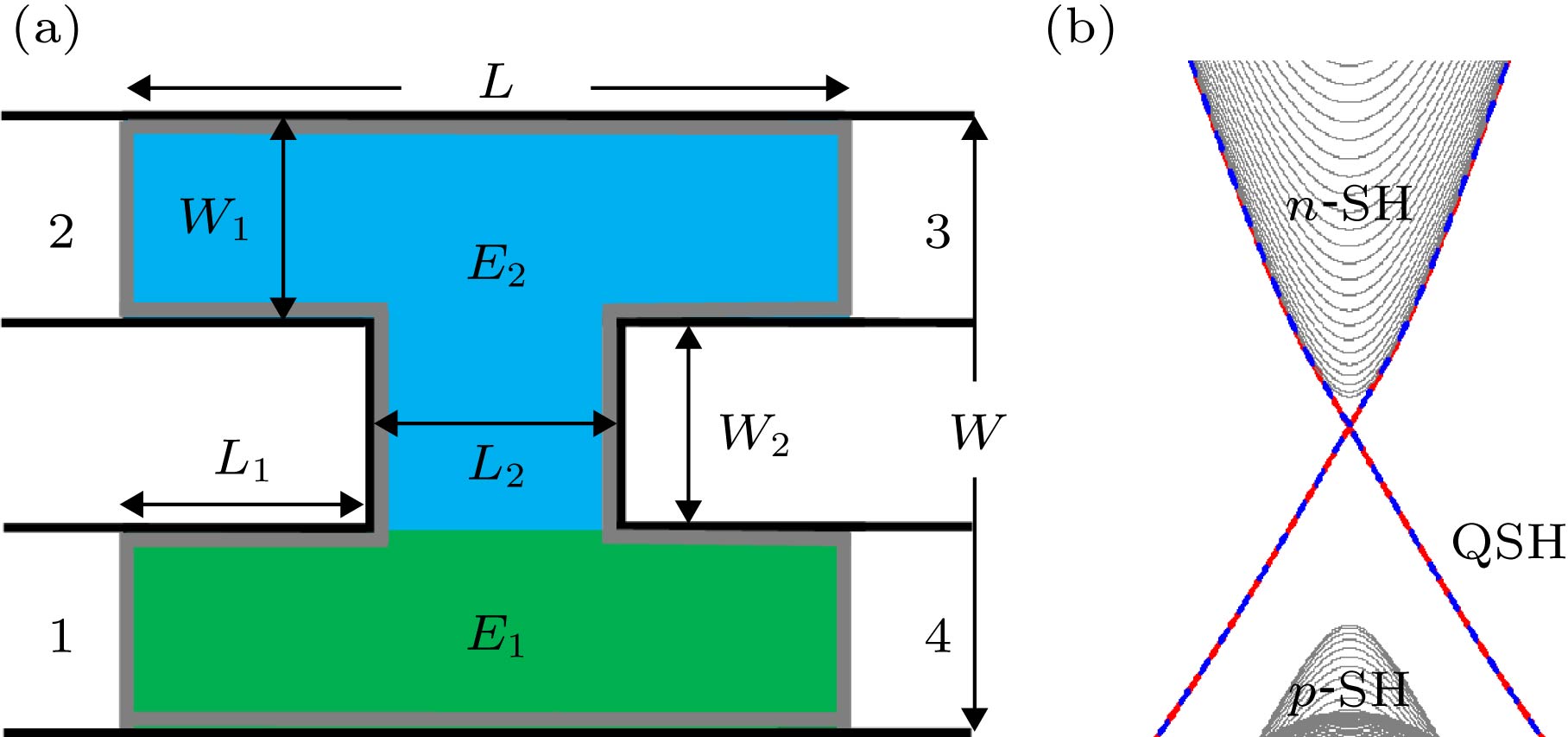
 下载:
下载:
